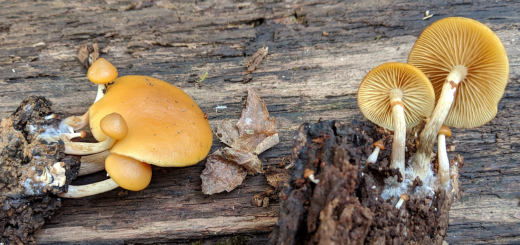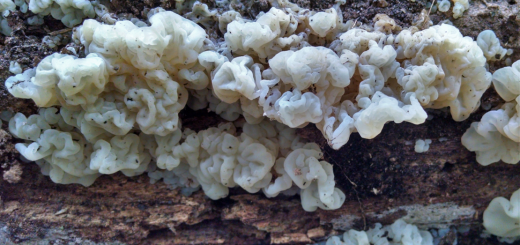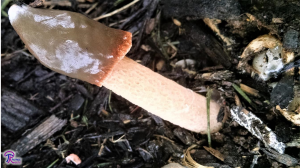#133: Russula virescens species group
Mushrooms come in all different colors, even green! Although green is an unusual color for mushrooms, certain mushrooms sporting green colors are common. The most frequently-encountered green mushrooms are from the Russula Of these, my favorite ones are the Quilted Green Russulas (also called Greencracked Brittlecaps), which belong to the Russula virescens species group. R. virescens can be found in North America, Europe, and Asia. However, preliminary DNA studies suggest that specimens found in North America actually belong to a few different species and should not be lumped in with R. virescens. Unfortunately, mycologists have yet to formally classify these American species. As a result, the North American species in the group can be called R. virescens for now.
The most conspicuous feature of the R. virescens species group is its green cap. Since the group comprises a number of different species, there is some variability in color and texture of the pileus. The pileus is green to yellow-green with the colored part breaking up into irregular patches that reveal paler color underneath. Cracks generally appear around the edge and work their way towards the center as the mushroom ages. Consequently, the center can be much darker than the edges. Other features of the cap include: its dry, slightly fuzzy texture; its often radially lined margin, and its convex to flat to centrally depressed shape. R. virescens is a medium-sized mushroom with a short stature typical of its genus: it grows 5-15cm (2-6in) across but only 3-9cm (1-3.5in) tall.
Underneath the cap, the mushroom looks like any number of other Russula species. It has gills attached to a smooth, central stipe. All these lower surfaces are white to cream in color and may discolor brown as the mushroom matures. R. virescens also features the brittle, crumbly flesh that is the defining feature of the Russulaceae. If your mushroom easily snaps in half or crumbles when thrown against a tree, it’s probably a Russula (Lactarius species also exhibit this characteristic, but they exude a milky latex when injured). Like most other mushrooms in the family, fungi in the R. virescens group deposit a white to creamy spore print.
R. virescens mushrooms are mycorrhizal, so they get their nutrients through mutualistic interactions with tree roots. The fungi give the trees scarce nutrients in exchange for sugar produced through photosynthesis. R. virescens is mycorrhizal with a variety of hardwoods, though Michael Kuo – author of MushroomExpert.com – has reported finding it under conifers on occasion. If the North American R. virescens is broken up into other species, host tree specificity is likely to be an important factor for identification. Kuo’s conifer-tolerant collections may represent an as yet unrecognized species.
Mushrooms in the R. virescens species group can be found in North America, Central America, Europe, and Asia. Within North America, they are widespread east of the Rocky Mountains and only rarely encountered on the West Coast.
North American mycologists have managed to separate two species from the R. virescens group based on morphological features. R. crustosa can be differentiated by its more distinct patches and tan-colored pileus that may include greenish tones. R. parvovirescens is found only in Eastern North America and features blue-green colors and larger, more distinct patches.
A few other Russula species that may be confused with the R. virescens group include: R. aeruginea, which has a solid green cap; R. olivacea, which is more olive in color, has a smooth cap, and leaves a pale yellow spore print; R. cyanoxantha, which has a smooth cap and usually has both green and purple colors on its pileus; and R. variata, which is smooth and normally has a cap with areas colored green and pink.
In some areas, you need to make sure that your collection is not Amanita phalloides, the Death Cap. That deadly mushroom can also have a green pileus. However, A. phalloides can be distinguished by the ring found near the top of the stipe, the sack-like volva encircling the base, and free gills. A. phalloides is common in Europe and was recently imported to Western North America, where its range is expanding.
R. virescens is considered to be the best-tasting of all russulas. This may sound like a dubious honor, especially if you remember that many Russula species are too acrid to eat. However, many people praise this mushroom for its nutty flavor, which can be strengthened by drying. R. virescens is most popular in Europe, since Americans for the most part ignore mushrooms in the generally inedible or bland Russula genus. The firm flesh and pleasant flavor mean it will pair well with a variety of dishes or can be used on its own. Try sautéing it or adding it to a soup or omelet. If you do collect R. virescens for the table, make sure that it displays the cracked cap texture. This will help you separate it from nearly all other look-alikes.
See Further:
http://www.mushroomexpert.com/russula_virescens.html
http://www.first-nature.com/fungi/russula-virescens.php
https://en.wikipedia.org/wiki/Russula_virescens
The Look-Alikes:
http://www.mushroomexpert.com/russula_crustosa.html
http://www.mushroomexpert.com/russula_parvovirescens.html
http://www.mushroomexpert.com/russula_aeruginea.html
http://www.mykoweb.com/CAF/species/Russula_olivacea.html
http://www.mushroomexpert.com/russula_cyanoxantha.html









![#011: Characteristics of Kingdom Fungi [Archived]](https://www.fungusfactfriday.com/wp-content/themes/hueman/assets/front/img/thumb-small-empty.png)


Nice article, however I am researching “parvovirescens” which appears to have been separated recently from virescens by a lined margin. I cannot yet verify, but I have seen no mention on this article, and think it may be worth looking into.
Yes, there are some other differentiating features, like the striate margin, that I left out (see MushroomExpert.com). Of course, there are still a dozen or so undescribed North American species in the virescens-crustosa group, so the important characteristics separating the species may change in the future.